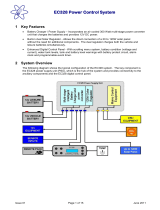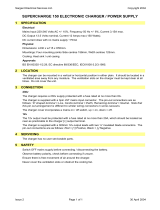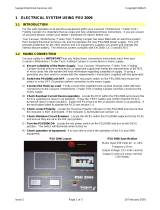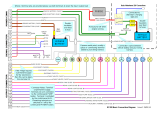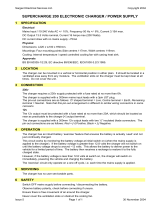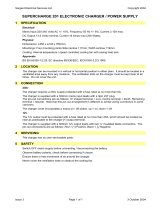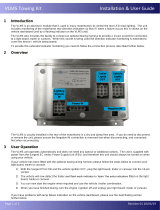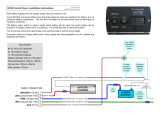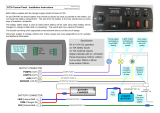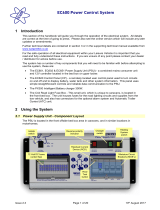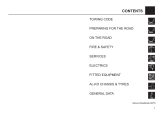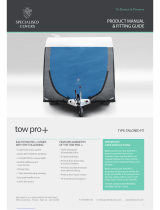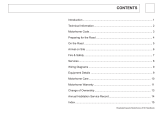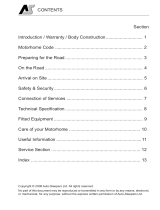Page is loading ...

EC175 Power Control System
Issue 1 Page 1 of 14 20 July 2014
1 Introduction
This section of the handbook will guide you through the operation of the electrical system.
Further technical details are contained later in this document or in the supporting technical manual
available from www.sargentltd.co.uk
For the safe operation of all electrical equipment within your caravan it is important that you read and
fully understand these instructions. If you are unsure of any point please contact your dealer /
distributor for advice before use.
The system has a number of key components that you will need to be familiar with before attempting to
use the system, these are:
· The EC175 series Power Supply Unit (PSU) - a combined mains 230V / 12V consumer unit and
charger / controller located in the front bed box.
· The EC360 or EC350 series Control Panel (CP) - a remotely located user control panel used to
turn circuits on and off and to display battery and water tank information (where applicable).
2 Using the System
The PSU is located in the front offside bed box.
2.1 EC175 Power Supply Unit – Component Layout

EC175 Power Control System
Issue 1 Page 2 of 14 20 July 2014
2.2 Activating the System
The EC175 system has a shutdown feature that should be used when the caravan is in storage or is
not being used for long periods of time. This allows the leisure electronics to be turned off when not
required to save battery power. When in the off state the alarm and tracking system supplies are still
active, most other supplies are turned off.
Before using the system please ensure the system shutdown switch is in the on position (button in).
PSU – 12V Controls
The black system shutdown button is shown on the
left. In is ON and out is OFF.
The other two switches are for 230V, and are
covered in section 2.3
2.3 Connecting to the Mains 230V supply and Safety checks
For your safety it is IMPORTANT that you follow these connections instructions each time your caravan
is connected to a mains supply. This section assumes that the system is complete and that a Leisure
battery has been installed (see 3.3).
A) Ensure suitability of the Mains Supply. Your caravan should only be connected to an approved
supply that meets the requirements of BS7671 or relevant harmonised standards. In most cases
the site warden will hold information regarding suitability of supply. If using a generator you also
need to comply with the requirements / instructions supplied with the generator. Please note that
some electronic generators may not be compatible with your leisure system. Further generator
operational information is contained in section 3.4.
B) Switch the PSU internal Power Converter OFF. Locate the green ‘Charger’ power switch on the
PSU and ensure the switch is in the off position (button out) before connection to the mains supply.
C) Connect the Hook-up Lead. Firstly connect the supplied hook-up lead (orange cable with blue
connectors) to the caravan and then connect to the mains supply.
D) Check Residual Current Device operation. Locate the RCD within the PSU and ensure the RCD
is switched on (lever in up position). Press the ‘Test’ button and confirm that the RCD turns off
(lever in down position). Switch the RCD back to the on position (lever in up position). If the test
button failed to operate the RCD see section 3.1 & 3.8.
E) Check Miniature Circuit Breakers. Locate the MCB’s within the PSU (adjacent to the RCD) and
ensure they are all in the on (up) position. If any MCB fails to ‘latch’ in the on position see section
3.1 & 3.8.
F) Turn the PSU ON. Locate the black ‘Shutdown’ button and ensure it is in the on position (press
button to change, button in = on, button out = off). Locate the green ‘Charger’ switch on the PSU
and turn to the on position (press button to change, button in = on, button out = off). The charger
switch will illuminate when turned on.
G) Check operation of equipment. It is now safe to operate the 12V and 230V equipment.

EC175 Power Control System
Issue 1 Page 3 of 14 20 July 2014
PSU – 230V Controls
Lever type switch, far left – Residual Current
Device (RCD) and main 230V on / off switch.
Push button, far left – RCD Test button.
3 x lever switches, right – Miniature Circuit
Breakers (MCB). Note the lever colour and MCB
rating may vary. See the safety and rating
sticker adjacent to the PSU for further details.
Green push switch, far right – Charger switch,
this switch turns the 12V battery charger on or
off. In is ON out is OFF.
Amber push switch – Heater switch, this switch
turns the 230V supply to the combination water
heater / central heating system on or off. In is
ON out is OFF.
Note the far left 12V DC Shutdown switch is
covered in section 2.2.
2.4 Operation while driving
The EC175 system is designed to shutdown parts of the system whilst the car engine is running. This
is to meet Electro Magnetic Compatibility (EMC) regulations and to ensure the safe operation of the
system.
Please ensure the system shutdown switch on the PSU is in the “on” (button in) position before towing
(see 2.2). This will ensure the electronic system is active and will therefore be able to control the
charging process, supply the refrigerator and monitor other system circuits.
2.5 Control Panel - Component Layout
EC350 Digital Control Panel (LED display)

EC175 Power Control System
Issue 1 Page 4 of 14 20 July 2014
EC360 Digital Control Panel (LCD display)
2.6 Control Panel Operation
Button Button Description
Power button. Press the power button to turn the leisure power on. Press the button
again to turn the power off. The adjacent LED will illuminate when the power is on, and
also the voltage of the selected battery will be displayed on the screen. When the car
engine is running this LED will flash to indicate the leisure battery is being charged.
Pump button. With the power on, press the pump button to turn the water pump on.
Press the button again to turn the pump off. The adjacent LED will illuminate when the
pump is on, and also the level of the water tank will be displayed on the screen (if the
optional onboard water tank is fitted).
Light button. With the power on, press the light button to turn the main internal lighting on.
Press the button again to turn the lights off. The adjacent LED will illuminate when the
lights are on. The lights will be turned on and off automatically each time the power button
is operated.
Awning Light button. With the power on, press the awning light button to turn the awning
light on or off. The adjacent LED will illuminate when the light is on.
EC360 EC350
L
Select / show leisure button. Use this
button to select the leisure battery. If the
battery is already selected the button will
display the battery voltage on the LED bar
graph display.
The LED next to the button will turn on to
show the battery is selected.
Levels / scroll button. Use
this button to scroll through the
various levels screens / menu
items or to cancel alarms /
warnings. Note: The screen
illumination / backlight will turn
off after a period of time. Press
the levels button to reactivate
the illumination.
Select button. Use this button
to select options / items or to
change settings.
V
Select / show vehicle button. If the tow
vehicle is connected and you need to use
the vehicle battery, press this button to
select it.
If the battery is already selected the button
will display the battery voltage on the LED
bar graph display.
The LED next to the button will turn on to
show the battery is selected.

EC175 Power Control System
Issue 1 Page 5 of 14 20 July 2014
3 System Technical Information
The following section provides further technical information relating to the electrical system.
3.1 Residual Current Device & Miniature Circuit Breakers
The Residual Current Device (RCD) is basically
provided to protect the user from lethal electric shock.
The RCD will turn off (trip) if the current flowing in the
live conductor does not fully return down the neutral
conductor, i.e. some current is passing through a
person down to earth or through a faulty appliance.
To ensure the RCD is working correctly, the test
button should be operated each time the caravan is
connected to the mains supply (see section 2.3)
The Miniature Circuit Breakers (MCB’s) operate in a
similar way to traditional fuses and are provided to
protect the wiring installation from overload or short
circuit. If an overload occurs the MCB will switch off
the supply. If this occurs you should investigate the
cause of the fault before switching the MCB back on.
The following table shows the rating and circuit allocation for the three MCB’s
MCB Rating Description (cable colour)
1 10 Amps 230V Sockets (white)
2 16 Amps
Combination water heater / central heating system (yellow) / Extra 230V
Sockets (white)
3 10 Amps Fridge (black) / 12V Charger (internally connected)
3.2 Battery Charger
The EC175PSU incorporates a fixed voltage battery charger / power converter. The battery charger /
power converter also powers the leisure equipment when the mains supply is connected. This module
supplies 13.8V DC to the leisure equipment up to a maximum of 12 Amps (155 Watts), therefore the
available power is distributed between the leisure load and the battery, with the leisure load taking
priority as per the following example:
Leisure load Available power for battery charging
3A 9A
6A 6A
9A 3A
12A 0A
WARNING
Under heavy loads the power supply unit case may become hot. ALWAYS ensure the ventilation
slots have a clear flow of air. Do not place combustible materials against / adjacent to the EC175.
The PSU will shutdown if overheated and will restart automatically when cool.

EC175 Power Control System
Issue 1 Page 6 of 14 20 July 2014
3.3 Leisure Battery
3.3.1 Type / Selection
For optimum performance and safety it is essential that only a proprietary brand LEISURE battery is
used with a typical capacity of 75 to 120 Ah (Ampere / hours). A normal vehicle battery is not suitable.
This battery should always be connected when the system is in use.
The PSU is configured to work with standard lead acid leisure batteries, and in most cases is also
compatible with the latest range of Absorbed Glass Matt (AGM) batteries. Before fitting non-standard
batteries please check that the fixed charging profile described in 3.2 is suitable for the type of battery
by referring to the battery documentation or battery manufacturer.
The battery feed is fitted with an inline fuse between the battery and the electrical harness, which is
usually located immediately outside the battery compartment or within 500mm of the battery. The
maximum rating of this fuse is 20A.
3.3.2 Installation & Removal
Always disconnect the 230V mains supply and turn the PSU green charger switch to the off position
(button out) before removing or installing the battery.
When connecting the battery, ensure that the correct polarity is observed (black is negative [-] and red
is positive [+]) and that the terminals are securely fastened. Crocodile clips must not be used.
WARNING
Explosive gases may be present at the battery. Take care to prevent flames and sparks in the vicinity
of the battery and do not smoke.
3.3.3 Operation / Servicing
Under normal circumstances it should not be necessary to remove the battery other than for routine
inspection of the terminals and “topping up” of the battery fluid where applicable. Please see
instructions supplied with the battery.
Note: Do not over discharge the battery. One of the most common causes of battery failure is when
the battery is discharged below the recommended level of approximately 11.5V. Discharging a battery
below this figure can cause permanent damage to one or more of the cells within the battery.
To prevent over discharge, the EC175 system incorporates a battery protect circuit that warns the
users and then disconnects the batteries when they fall below set values. See 3.6 below for details.
3.4 Generator Usage
Caution should be used before connecting a generator to your caravan.
WARNING
Never start or stop the generator while electrical loads are connected and switched on. Start the
engine, let it stabilise and then connect the electrical load. To stop the engine, disconnect the
electrical load and let engine stabilise before switching off
Whilst some generators use electronic inverter technology, others use a more basic principle to
generate the 230V supply. Preference should be to choose a generator which produces a consistent
sinusoidal wave form with accurate voltage control.
The Reverse Polarity warning light on the PSU may illuminate when using a Generator. This is a
normal side effect when using some types of generator. Instead of connecting the neutral conductor to
earth, some generators centre tap the earth connection making both neutral and live conductors 110V
above earth. This 110V difference causes the neon polarity indicator to illuminate.
In most cases it is safe to use a generator, but please consult the generator handbook for further
information.
3.5 Awning Light Operation
The awning light is control by the control panel awning light button. On some models the awning light
is also linked to the optional alarm system to enable remote control with the alarm fob.

EC175 Power Control System
Issue 1 Page 7 of 14 20 July 2014
3.6 System Warnings
The system incorporates a number of warnings that are active at specific times. These are
summarised below, and also covered by relevant sections of this manual.
Warning When Type
Fresh water level low With pump turned on and fresh water
level low (less than 25% full)
Only available when an onboard tank is
fitted
Message on screen and 30 second
audible beep
With control panel power on and leisure
battery selected (as active battery) and
the voltage level falls below 10V
Message on screen (or flashing LED
bar graph on EC350) and 30 second
audible beep.
With control panel power on and leisure
battery selected (as active battery) and
the voltage level is below 9V
Message on screen (or flashing LED
bar graph on EC350) and 30 second
audible beep. If no action taken after
30 seconds then the system will switch
the power of to prevent severe
discharge of the battery
Leisure battery voltage
low
Note: This is an emergency cut off level to protect the battery from severe
damage. You should not rely on this cut off level during normal operation, but
manage your power consumption to a discharge level of 11.5V or above.
This cut off only applies to power drawn from the battery by the leisure equipment
that is controlled by the control panel power switch; it will not protect the battery
from discharge by permanently connected equipment.
Leisure battery voltage
high
With control panel power on or off and
leisure battery is selected (as active
battery) and the voltage level rises
above 15.4V
Message on screen (or flashing LED
bar graph on EC350) and repeated
beeps from the control panel. The
beeping will not stop until the fault is
cleared.
Vehicle battery
warnings
If the vehicle battery is selected instead of the leisure battery, then the same
warnings described above for the leisure battery are applied to the vehicle
battery.
Engine running When the engine is started the system
power will be turned off
Message on screen (EC360 only) and
power button LED flashing indicating
both batteries are connected for
charging.
3.7 12 Volt DC Fuses
WARNING
When replacing fuses always replace a fuse with the correct value. NEVER replace with a higher value /
rating as this could damage the wiring harness. If a replacement fuse ‘blows’ do not keep replacing the
fuse as you could damage the wiring harness. Please investigate the fault and contact your dealer.
The following table shows the fuse allocation for the 12 fuses fitted to the PSU. Please note that fuses
are dependant on PSU versions and installation, so not all fuses may be present or used.
Fuse Rating Fuse Colour Description
1 10 Amps Red Water Pumps / Toilet
2 2 Amps Grey Permanent Supplies / Electronics
3 5 Amps Tan Heater Fans
4 10 Amps Red Lights
5 15 Amps Blue Fridge Element (during towing)

EC175 Power Control System
Issue 1 Page 8 of 14 20 July 2014
6 10 Amps Red Extractor Fans
7 5 Amps Tan Ignitions
8 10 Amps Red Switched Lights
9 20 Amps Yellow Vehicle Battery
10 20 Amps Yellow Leisure Battery
11 10 Amps Red 12V Sockets
12 15 Amps Blue Charger
The following table shows details of the fuse(s) located at the Leisure battery.
Fuse Rating Fuse Colour Description
Battery 1 20 Amps Yellow Fuse remotely located near battery
3.8 Common Fault Table
Fault Possible Cause Proposed Fix
Connecting lead between
the site and Leisure
Vehicle not connected
Check and connect lead as per 2.3C
RCD switched off Reset RCD as per 2.3D
RCD not operating
correctly
Check supply polarity; if the RCD continues to fail contact your Dealer
as there is probably an equipment or wiring fault.
MCB switched off
Reset MCB by switching OFF (down position) then back ON (up
position), if the MCB continues to fail contact your Dealer as there is
probably an equipment or wiring fault.
No or deficient supply
from site
Contact site Warden for assistance.
No 230 volt
output from PSU
Other fault Contact your Dealer.
Control Panel has no
display
Backlight / illumination may have switched off. Press the power
button or select button to reactivate the backlight.
Check batteries and fuses, turn PSU shutdown switch and charger
switch on and ensure mains supply is connected.
Check control panel connecting lead at PSU and behind Control
Panel.
Contact your Dealer.
12v Power turns off
Battery protect feature has operated to protect the Vehicle battery
and or the Leisure battery. See 3.6
Engine has been started, all equipment has been disconnected to
meet EMC requirements. See 2.4
Control Panel
Problems
Control Panel locked /
erratic function
Observe control panel handling instructions
Control panel software may have crashed. Reboot control panel by
turning off the PSU isolate switch. Wait 30 seconds then turn the
switch back on.
No 230v supply Check all above.
Charger not switched on Turn charger switch on, switch will illuminate.
Battery not connected and
/ or charged
Install charged battery as per 3.3
Power button on control
panel not switched to on
Turn power on at control panel.
Battery flat / Battery fuse
blown
Recharge battery, check fuses, check charging voltage is present at
battery.
Fuse blown
Check all fuses are intact and the correct value fuse is installed as
per fuse table.
No 12 volt output
from PSU
Equipment switched off /
unplugged
Check equipment is switched on and connected to the 12v supply.

EC175 Power Control System
Issue 1 Page 9 of 14 20 July 2014
Fault Possible Cause Proposed Fix
PSU overheated / auto
shutdown operated
Reduce load on system. Allow PSU to cool down. PSU will
automatically restart when cool.
Other fault Contact your Dealer.
Fuse blown Replace fuse with correct value as per fuse table.
Pump turned off Turn pump on by pressing the pump button at the control panel.
Pump not
working
Setting incorrect
Both the internal and external pump feeds are controlled from the
control panel. To alter the setting of the pump switch see your dealer.
Ensure the setting matches your desired requirement.
3.9 Contact details
Sargent Electrical Services Limited, provide a technical help line during office hours. Please contact
01482 678981 if you require technical help. For out of hour support please refer to the tech support
section of the Sargent web site www.sargentltd.co.uk

EC175 Power Control System
Issue 1 Page 10 of 14 20 July 2014
4 EC350 Control Panel
In addition to the information contained in section 2.6 (Control Panel Operation), the following section
provides further detail information.
4.1 LED Bar Graph
The LED Bar Graph displays the voltage of the selected battery.
LED Colour Voltage reading
1 Red < 9.5 (<9 LED Flashes)
2 Red 9.5 - 10.9
3 Amber 11 - 11.4
4 Amber 11.5 - 11.9
5 Amber 12.0 - 12.4
6 Green 12.5 - 12.9
7 Green
13.0 - 13.4
8 Green
13.5 - 13.9
9 Green
14.0 - 14.4 (>15.4 LED Flashes)
When the control panel power is on and the leisure battery is selected (Leisure battery button LED on),
pressing the leisure battery
L
button will display the battery voltage on the bar graph.
When the control panel power is on and the vehicle battery is selected (Vehicle battery button LED on),
pressing the vehicle battery
V
button will display the battery voltage on the bar graph.

EC175 Power Control System
Issue 1 Page 11 of 14 20 July 2014
5 EC360 Control Panel
In addition to the information contained in section 2.6 (Control Panel Operation), the following section
provides further detail information.
5.1 Screen Illumination Operation
The screen illumination (backlight) is turned on and off automatically. Pressing the levels button will
reactivate the illumination.
5.2 Header Area
LBatt 13:45 V112
The header area of the screen shows the following information;
LBatt
or
VBatt
Leisure battery selected. This symbol indicates that the leisure battery is selected as the battery
to use or to charge. This is the default setting.
Vehicle battery selected. This symbol indicates that the vehicle battery is selected as the battery
to use or to charge. This is only available when the car is connected and the vehicle battery has
been selected.
13:45
Clock display. This show the current time in a 24 hour format.
V112
This shows the software version of the control panel.
5.3 LED Bar Graph
The LED Bar Graph displays the voltage of the selected battery.
LED Colour Voltage reading
1 Red < 9.5 (<9 LED Flashes)
2 Red 9.5 - 10.9
3 Amber 11 - 11.4
4 Amber 11.5 - 11.9
5 Amber 12.0 - 12.4
6 Green 12.5 - 12.9
7 Green
13.0 - 13.4
8 Green
13.5 - 13.9
9 Green
14.0 - 14.4 (>15.4 LED Flashes)
When the control panel power is on, pressing the levels button will display the battery voltage on
the bar graph.
5.4 Information Area
The main information area can display a variety of system information screens. These have been
designed to present the information in a clear and concise form, while retaining technical detail for the
more advanced users.
The selected screen can be changed by using the levels / scroll button, and work on a continuous loop
basis (when the last screen is reached the scrolling returns to the first). The selected screen may be
changed automatically by the system depending on the action being performed.

EC175 Power Control System
Issue 1 Page 12 of 14 20 July 2014
Leisure Battery
13.9V GOOD
1 – Leisure Battery
Here leisure battery information is shown.
The digit display shows the battery voltage followed by a guide to the battery
charge condition (i.e POOR, FAIR, GOOD, CHARGING).
The voltage is also shown on the LED bar graph below the display.
Pressing the levels button to move to the next screen.
Vehicle Battery
12.2V FAIR
2 – Vehicle Battery
Here, if the tow car is connected, the vehicle battery information is shown
similar to the leisure battery (see above).
The voltage is also shown on the LED bar graph below the display.
Pressing the levels button to move to the next screen.
Fresh Water Level
25%
3 – Water Tank
The 3
rd
screen shows information relating to optional onboard water tank.
This screen is only available when the tank is fitted.
The tank water level is shown in ¼ steps (i.e. 0%, 25%, 50%, 75% & 100%)
The displayed level is continuously refreshed if the water pump is turned on.
Pressing the levels button to move to the next screen.
Select Battery
Battery = LEISURE
4 - Select Battery
Here you can select which battery to use or charge.
By default the leisure battery is automatically selected. If the mains supply is
connected and the charger turned on, this battery will also be charged.
If you need to select the vehicle battery, and the tow car is connected, press
the select button to change the selected battery from leisure to vehicle (or
vice versa).
The relevant symbol (LBatt) or (VBatt) will be shown in the header area.
Information relating to the selected battery is shown on the screen.
Pressing the levels button to move to the next screen.
Adjust Hour
Hour = 13
7 – Adjust Hour
Here you can adjust the hour display.
Press the select button to increase the value by 1. Press and hold the
button to rapidly increase the value.
Pressing the levels button to move to the next screen.
Adjust Minute
Minute = 45
8 – Adjust Minute
Here you can adjust the minute display.
Press the select button to increase the value by 1. Press and hold the
button to rapidly increase the value.
Pressing the levels button to move to the next screen.

EC175 Power Control System
Issue 1 Page 13 of 14 20 July 2014
SARGENT EC360
LCD Control Panel
9 – System Info
Here you can view the control panel model number (i.e. EC360). Note that the
software version number is also shown in the top right.
Pressing the levels button to move to the first screen.
The system can display a number of warnings. The control panel will beep and display the appropriate
message. Press the levels button to cancel the warning. See 3.6 for further details.

EC175 Power Control System
Issue 1 Page 14 of 14 20 July 2014
6 Technical Data & Approvals
6.1 Outline specification – EC175PSU & EC350/360 Control Panel
INPUT 230V 230 Volts / 0 to 16 Amps + / - 10%
OUTPUT 230V
RCD protected, 3 x MCB outputs of 1x16A and 2x10A
Separate switched channels for combination heater and
charger
INPUT 12V 2 x 20A battery inputs via 9 way connector
OUTPUT 12V
20A total output via multiple switched channels protected
by 12 fused outputs
Built in
CHARGER
Input 220-240 Volts AC +/- 10%, Frequency 50 Hz +/- 6%,
Current 3A max.
DC Output 13.8 Volts nominal, Current 12 Amps max (155
Watts).
Signal INPUT
4 x Fresh water level (direct to control panel), 1 x Engine
running, plus multiple vehicle connections
Fresh water negative sensed
Data IN / OUT Data communication to Control Panel via 8 way connector
IP rating IP31
Operating
temperature
Ambient 0 to 35° Centigrade
PSU case temperature with full load 65° C Max
Automatic shutdown and restart
if overheated / overloaded
EC175
PSU
Overall size (HxWxD) 260 x 273 x 110mm
Clearances 75mm above, 20mm below, 50mm left & right
Fixing centres 262 x 224mm
Weight 2.2 Kg
EC350 & EC360
Control Panel
Overall size (HxWxD) 95 x 200 x 25mm
Cut-out size (HxW) 82 x 178mm
Fixing centres 190mm
Weight 180 g
6.2 Approvals
System: BSEN 1648-1, BSEN1648-2 compliant, BS7671: 2008 compliant
Residual Current Device: RCD 40A 30mA trip to BS EN 61008
Miniature Circuit Breakers: MCB’s type C 6000A breaking capacity to BSEN 60898
Electro Magnetic Compatibility (EMC) directive 89/336/EEC
Integrated Charger Module: BS EN 60335-1/2.29, 89/336/EEC, IEC61000-3.2/3:1995, EMC certificate 5A121501E
3rd party tested.
Low Voltage Directive: 2006/95EC TUV-014900-A1, EN55022, Class B, EN55024/ Level 2
6.3 Declaration of Conformity
Equipment: Leisure Power Control System Model name: EC175, EC350, EC360
I hereby declare that the equipment named above has been designed to comply with the relevant sections of the
above referenced approvals. The unit complies with all essential requirements of the Directives.
Signed: Name: Position: Manufacturer:
Date:
I L Sargent Technical Director
Sargent Electrical Services Ltd
Unit 39, Tokenspire Business Park
Woodmansey, Beverley
East Yorkshire, United Kingdom
Whilst every effort has been made to ensure the accuracy and completeness of this document, no guarantee is given against errors or
omissions. This document may be updated / improved over time therefore please check with your dealer / supplier for update
information or visit www.sargentltd.co.uk
/
